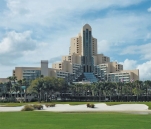Carrier: How to Reduce Energy Consumption in Hotels

Globally, buildings account for 40% of total energy consumption, significantly higher than energy used for transportation or industry. Within buildings, heating, ventilation and air conditioning (HVAC) takes up the largest slice of the energy consumption. This proportion is approximately 40% in the US and is expected to be much higher in the warmer and more humid tropical weather of South East Asia.
Among buildings, hotels are some of the most energy intensive due to the long operating hours and high demand for comfort cooling. Comfort cooling could account for about 60% of the total hotel energy consumption in tropical weather. And the highest energy consumption area is concentrated in the chiller plant system. Chiller plant system in hotel is typically the single largest consumer of energy. It could account for an estimated 45% of the total hotel energy consumption. To save energy, and electricity bills, it is critical that chiller plant systems are operating at maximum efficiency at all time. With the new technologies, product and controls solutions available and tested in the field, there are significant opportunities to improve chiller plant efficiency of existing buildings, particularly energy intensive buildings such as hotels.
The application of modern technologies and equipment for air-conditioning systems, refrigeration, monitoring, management and control, tested in real conditions (on real projects / objects), provides new opportunities for improving energy efficiency refrigerant centers of existing buildings, including such energy-intensive as are hotels.
Carrier’s “Energy Savings in Hotels” is a program specifically designed to help hotels identify, realize and sustain significant energy savings from existing chiller plant systems. Building comfort cooling systems are typically designed to cater for peak load, with some safety factors to cater for unforeseen future demand. Equipment are evaluated based on the full load efficiency performance. However, in actual operations, hotels are often operating at part load.
Full content of this issue you can read here
The full version of the article can be read in our printed issue, also you can subscribe to the web-version of the magazine
 Text: Mikhail Terekhov, Senior Technical Expert, Ph.D. In Engineering Science, ASHRAE member
Text: Mikhail Terekhov, Senior Technical Expert, Ph.D. In Engineering Science, ASHRAE member


